Transmitting only the letter "S" in Morse code on December 12, 1901,
Guglielmo Marconi harnessed radio waves to send the first
transatlantic wireless transmission from Great Britain to Newfoundland
and revolutionized communication throughout the world. As he developed
a network of wireless (telegraphic) stations under the Marconi
Wireless Telegraph Company of America (owned by British Marconi),
others foresaw a future for transmitting voice and music (telephonic
transmission). In 1906, Reginald A. Fessenden, who invented the
continuous-wave transmitter, broadcast violin music and holiday
greetings to ships at sea on Christmas Eve. That same year Lee de
Forest patented the first radio tube, the audion (tube), which
reproduced sound with reasonable fidelity. In 1913, Edwin Howard
Armstrong invented the regenerative or feedback circuit that fed a
radio signal through the radio tube 20,000 times per second,
increasing its power and allowing for the broadcasting of a more
powerful signal. David Sarnoff, then an executive with American
Marconi, declared in 1916 that he planned to "make radio a household
utility in the same sense as a piano or phonograph. The idea is to
bring music into the homes by wireless."
|
|
|
|
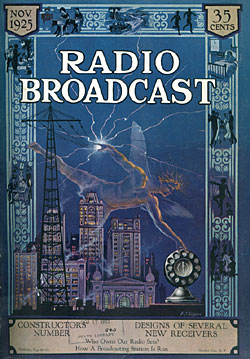
|
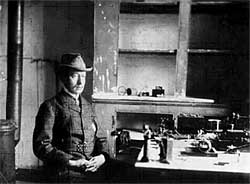
|
|
Radio Broadcast, a trade publication, regularly
printed a list of active radio stations operating at a minimum of one
kilowatt. By 1926, there were six radio stations operating in
Virginia. WRVA was the most powerful.
Cover illustration to Radio Broadcast, November 1925. |
Guglielmo Marconi inside the
station at St. John's, Newfoundland, Canada, after receiving the first
transatlantic wireless signal. 1901. Courtesy of the Marconi
Collection, Essex Record Office, Chelmsford, U.K. |
| |
Before World War I, American Marconi was negotiating to buy exclusive
use rights to the most powerful generator of radio waves in the world,
the Alexanderson alternator, from General Electric (GE), an
advancement that would enable Marconi to control wireless
communications around the world. When war erupted in Europe, the
United States Navy took control of all radio installations, including
those of American Marconi. Although negotiations began again after
1918, a GE lawyer, Owen Young, with encouragement from the government,
devised a plan to purchase American Marconi from its parent British
company to prevent foreign interests from controlling United States
communications. On October 17, 1919, the Radio Corporation of America
(RCA) was incorporated to control the radio patents of GE, American
Telephone and Telegraph (AT&T), Westinghouse, and the United Fruit
Company. General Electric purchased the shares of American Marconi
from British Marconi and forced American Marconi to transfer the
company's assets and operation to RCA.
|
| |
|
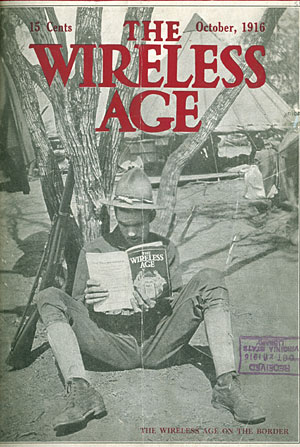 |
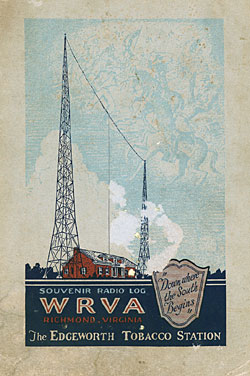 |
|
The cutting of telegraph cables between the United
States and Europe during World War I hastened the development of radio
telegraphy. The government halted any ongoing radio patent litigation
to encourage unhindered development of radio technology. "The Wireless Age on the Border." Wireless Age,
October 1916.
|
Radio stations provided listeners
with log books to track where programs reached their audiences. Early
radio stations often reached far beyond their local audiences to
listeners in other states and, occasionally, in other countries.
WRVA Souvenir Radio Log. 1929. Booklet. Noting his favorite
broadcasts in one week, the owner of this log listened to programs
from WRVA (Richmond), WPTF (Raleigh), and WEAF (New York). He also
noted that one of his favorite programs was the "South Sea Islanders,"
broadcast from KDKA (Pittsburgh). |
| |
Competing against RCA, the Westinghouse Company moved headlong
into building a broadcasting business. Although amateurs throughout the
nation experimented with broadcasting, talking, or playing phonograph
music or instruments, the broadcasting revolution really began on
November 2, 1920, when Westinghouse's KDKA, operating out of Pittsburgh,
broadcast results of the presidential election between Warren G. Harding
and James M. Cox. Although the Detroit News radio station, an amateur
station, also broadcast the election results, Westinghouse publicized the
event extensively for the purpose of developing an interest in its radio
equipment. KDKA continued broadcasting regularly, and Westinghouse
established radio stations in Boston, Chicago, and New York.
|
| |
|
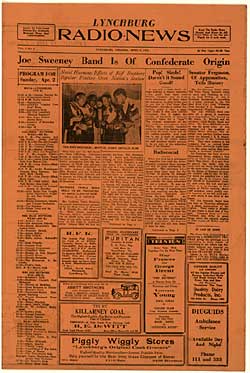 |
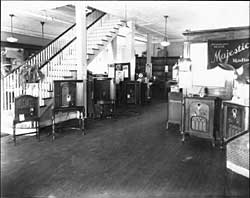 |
|
Trade publications, such as the
Lynchburg Radio-News and the Danville Radio News, provided
program information and tidbits of radio gossip. Inaugural issue of Lynchburg Radio-News,
February 19, 1933. |
Radio store, Hampton. 1930.
Photograph by Christopher E. or Happy Cheyne.
Courtesy of the
Christopher E. Cheyne Photograph Collection, City of Hampton
Historical Collection.
|
| |
By the end
of 1922, more than five hundred radio stations had been established
throughout the United States. Within two years, the number had increased
to 1,400, as a wide variety of businesses and organizations, such as
universities, department stores, newspapers, and banks, operated
broadcasting stations. With more than 400,000 households owning radio sets
by 1923, the medium had become a national phenomenon. Within a decade,
more than one million listeners tuned in.
|
|
|
|